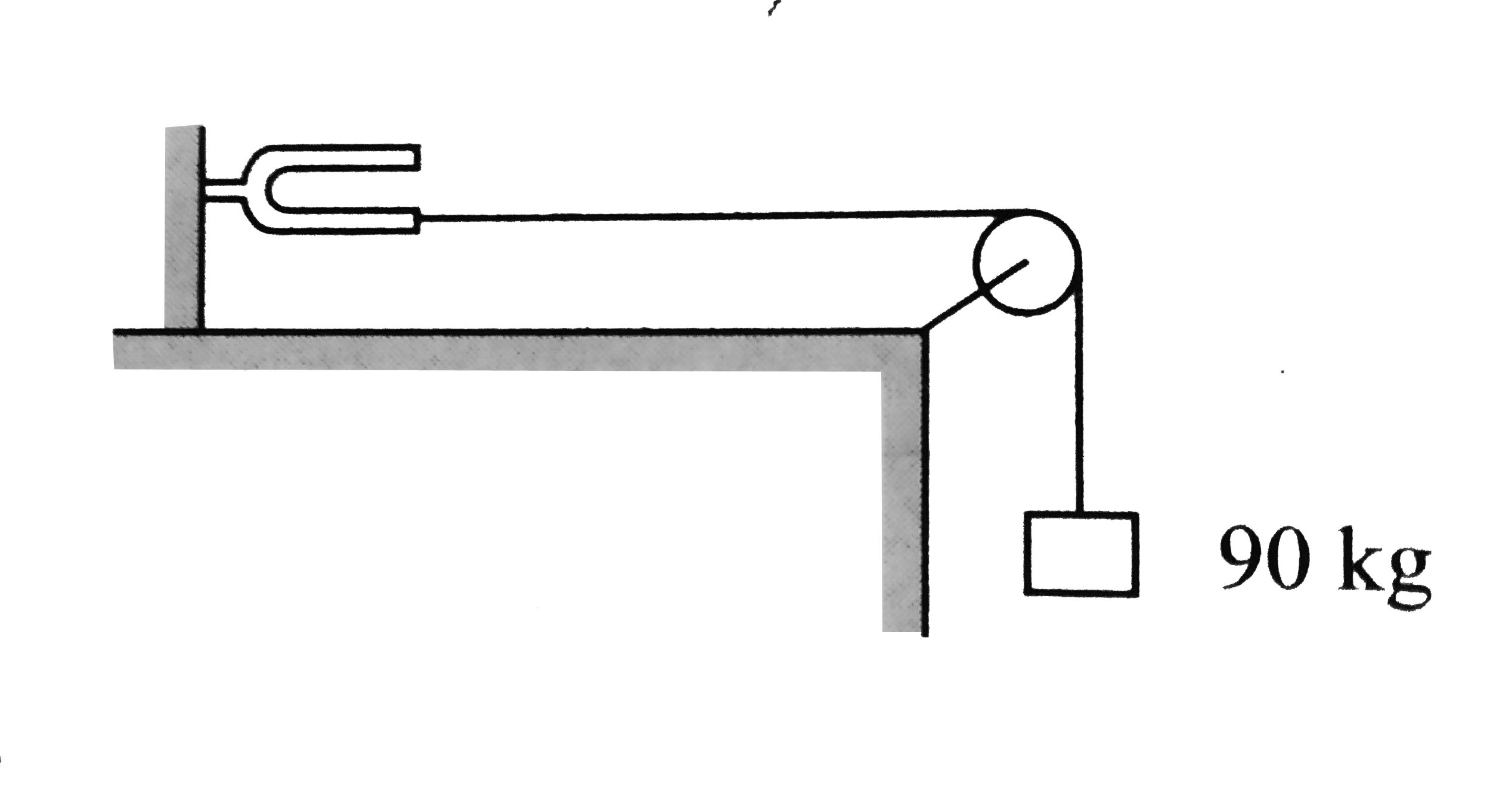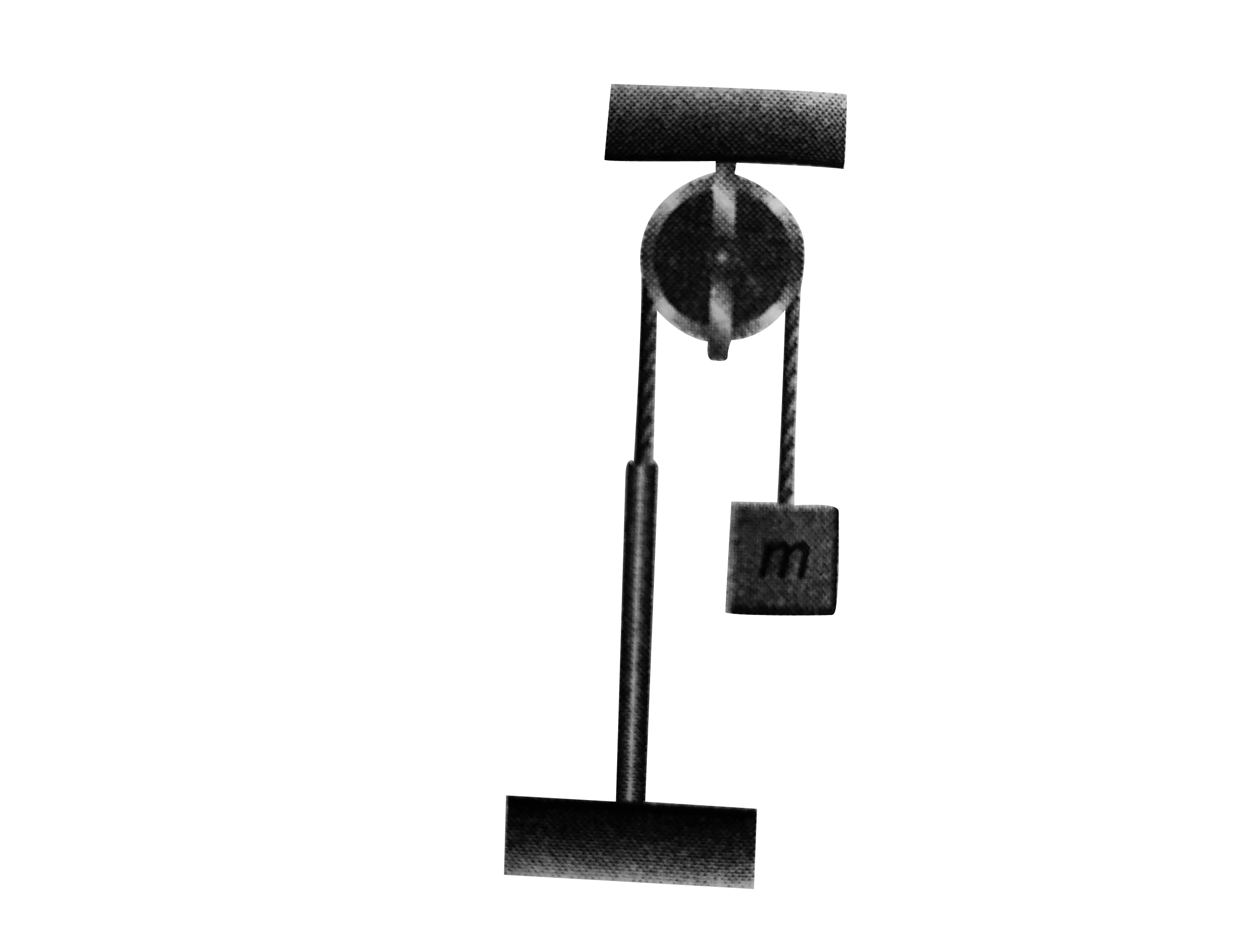One end of a long string of linear mass dnesity 8.0×10−3kgm−1 is connected to an electrically driven tuning fork of frequency 256 Hz. The other end passes over a pulley and is tied to a pan containing a mass of 90 kg. The pulley end absorbs all the incoming energy so that reflected waves at this end have negligible amplitude. At t=0 the left end (fork end) of the string x=0 has zero transverse displacement (y=0) and is moving along positive y-direction. The amplitude of the wave is 5.0 cm. Write down the transverse displacement y as function of x and t that describest the wave on the string.
The correct Answer is:y=0.005sin(ωt±kx); here ω
=1.61×103s−1,k=4.84m−1
x and y are in m.
To find the transverse displacement y as a function of x and t for the wave on the string, we will follow these steps:
Step 1: Identify the Given Values
- Linear mass density μ=8.0×10−3kg/m
- Frequency f=256Hz
- Mass hanging from the string m=90kg
- Amplitude A=5.0cm=0.05m
Step 2: Calculate the Tension in the String
The tension T in the string due to the hanging mass is given by:
T=mg=90kg×9.8m/s2=882N
Step 3: Calculate the Velocity of the Wave
The velocity v of the transverse wave on the string can be calculated using the formula:
v=√Tμ=√882N8.0×10−3kg/m
Calculating this gives:
v≈√110250≈332m/s
Step 4: Calculate the Angular Frequency ω
The angular frequency ω is given by:
ω=2πf=2×3.14×256≈1600rad/s
Step 5: Calculate the Wavelength λ
The wavelength λ can be calculated using:
λ=vf=332m/s256Hz≈1.297m
Step 6: Calculate the Wave Number k
The wave number k is given by:
k=2πλ=2×3.141.297≈4.84m−1
Step 7: Write the Equation for Transverse Displacement y
The general form of the wave equation traveling in the positive y-direction is:
y(x,t)=Asin(ωt−kx)
Substituting the values we have:
y(x,t)=0.05sin(1600t−4.84x)
Final Answer
Thus, the transverse displacement y as a function of x and t is:
y(x,t)=0.05sin(1600t−4.84x)
- Linear mass density μ=8.0×10−3kg/m
- Frequency f=256Hz
- Mass hanging from the string m=90kg
- Amplitude A=5.0cm=0.05m
The tension T in the string due to the hanging mass is given by:
T=mg=90kg×9.8m/s2=882N
The velocity v of the transverse wave on the string can be calculated using the formula:
v=√Tμ=√882N8.0×10−3kg/m
Calculating this gives:
v≈√110250≈332m/s
The angular frequency ω is given by:
ω=2πf=2×3.14×256≈1600rad/s
The wavelength λ can be calculated using:
λ=vf=332m/s256Hz≈1.297m
The wave number k is given by:
k=2πλ=2×3.141.297≈4.84m−1
The general form of the wave equation traveling in the positive y-direction is:
y(x,t)=Asin(ωt−kx)
Substituting the values we have:
y(x,t)=0.05sin(1600t−4.84x)
Thus, the transverse displacement y as a function of x and t is:
y(x,t)=0.05sin(1600t−4.84x)
Topper's Solved these Questions
- TRAVELLING WAVESBOOK - RESONANCE ENGLISHCHAPTER - TRAVELLING WAVESEXERCISE - Exercise- 1 PART I
23 Videos
- TRAVELLING WAVESBOOK - RESONANCE ENGLISHCHAPTER - TRAVELLING WAVESEXERCISE - Exercise- 1 PART II
30 Videos
- TRAVELLING WAVESBOOK - RESONANCE ENGLISHCHAPTER - TRAVELLING WAVESEXERCISE - Solved Miscellaneous Problems
7 Videos
- TEST SERIESBOOK - RESONANCE ENGLISHCHAPTER - TEST SERIESEXERCISE - PHYSICS
130 Videos
- WAVE ON STRING BOOK - RESONANCE ENGLISHCHAPTER - WAVE ON STRING EXERCISE - Exercise- 3 PART II
7 Videos
Similar Questions
One end of a long string of linear mass density 10−2kgm−1 is connected to an electrically driven tuning fork of frequency 150 Hz. The other end passes over a pulley and is tied to a pan containig a mass of 90 kg. the pulley end absorbs all the incoming energy so that reflected waves from this end have neglidible amplitude , At t =0, the left end (fork end ) of the string is at x=0 has a transverse displacement of 2.5 cm and is moving along positive y-direction. the amplitude of the wave is 5 cm. write down the transverse displacement y (in cetimetres) as function of x(in metres) and t (in seconds ) that describes the wave on the string.

View SolutionOne end of a horizontal rope is attached to a prong of an electrically driven fork that vibrates at 120Hz. The other end passes over a pulley and supports a 1.50kg mass. The linear mass density of the rope is 0.0550kg/m.
(a) What is the speed of a transverse wave on the rope?
(b) Whatis the wavelength?
How would your answer to parts (a) and (b) change if the mass were increased to 3.00kg?
View Solution
Knowledge Check
A string of mass 3 kg is under tension of 400 N. the length of the stretched string is 25 cm. if the transverse jerk is stuck at one end of the string how long does the disturbance take to reach the other end?
A0.043sB4.33SC0.055 sD0.034 s
One end of 12.0m long rubber tube with a total mass of 0.9kg is fastened to a fixed support. A cord attached to the other end passes over a pulley and support an object with a mass of 5.0kg. The tube is struck a transverse blow at one end. Find the time required for the pulse to reach the other end.(g=9.8m/s2)

View SolutionA string of length 2m is fixed at two ends. It is in resonance with a tuning fork of frequency 240 Hz in its third harmonic. Then speed of wave sound in string and its fundamental frequency is:
View SolutionIf a string fixed at both ends having fundamental frequency of 240Hz is vibrated with the help of a tuning fork having frequency 280Hz, then the
View SolutionA string fixed at both ends whose fundamental frequency is 240Hz is vibrated with the help of a tuning fork having frequency 480Hz, then
View SolutionA string of mass per unit length μ is clamped at both ends such that one end of the string is at x=0 and the other is at x=L. When string vibrates in fundamental mode, amplitude of the midpoint of string is a and tension in the string is F. Find the total oscillation energy (in J) stored in the string. (Use L=1 m, F = 10N, a = 1/pi m).

View SolutionA stretcded sting resomates with tuning fork of frequency 512 Hz. When length o fthe string is 0.5 m. the length of the string required to vibrate resonantly with a tuning fork of frequeny 256 Hz would be
View SolutionIn an experiment of standing waves, a string 90cm long is attached to the prong of an electrically driven tuning fork that scillates perpendicular to the length of the string at a frequency of 60Hz. The mass of the string is 0.044kg. What tension (in newton) must the string be under (weights are attached to the other end) if it is to oscillate in four loops?
View Solution
